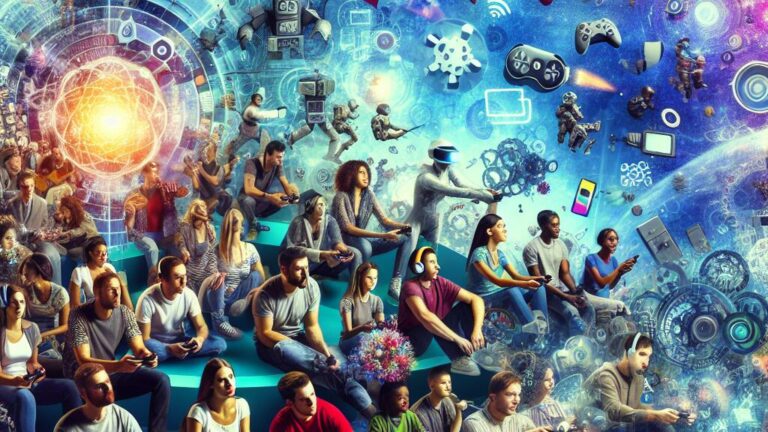Gamification Strategies in Digital Experiences
Infusing gamification strategies into digital experiences creates a vibrant tapestry of user engagement, harnessing the very elements that make games so captivating. Picture it: point systems flashing like neon signs, leaderboards buzzing with competitive energy, and achievement badges shining brightly—transforming the drudgery of mundane tasks into exhilarating challenges. Suddenly, what was once routine morphs into a thrilling contest, sparking that fiery sense of competition and accomplishment within users. They find themselves irresistibly drawn to interact more frequently with the platform.
But wait! There’s more to this playful paradigm shift. Thoughtfully crafted gamification offers instantaneous feedback loops—users can watch their progress unfold in real-time like a racehorse sprinting down the track. This delightful instant gratification not only boosts satisfaction but also weaves an intricate web of sustained involvement with content that keeps them coming back for more. Yet here lies the art: achieving just the right balance between challenge and skill is crucial; tip too far in either direction and you risk losing your audience’s interest.
When done right? Gamification doesn’t merely enhance user experience—it propels conversion rates skyward while forging unbreakable loyalty to brands. The magic happens when businesses create communities around their products where user-generated content flourishes alongside social sharing, all fueled by this dynamic game-inspired framework.
Motivating Users Through Game Mechanics
Game mechanics, those fascinating little cogs in the wheel of user engagement, have emerged as dynamic catalysts across digital landscapes and applications. Imagine a world where point scoring, shiny badges, and competitive leaderboards dance together to forge an exhilarating sense of achievement and rivalry among users! It’s not just about enhancing interaction; it’s about transforming the humdrum into something irresistibly compelling. Users find themselves caught in a whirlwind of intrinsic desires and external rewards—an irresistible cocktail that game mechanics expertly exploit to elevate participation and retention rates.
Now picture this: a vibrant community blossoming around these very game mechanics, amplifying motivation to astonishing heights. What fuels players? The thrill of social interactions! When peers recognize their efforts, it acts like rocket fuel for ambition. By weaving in collaborative challenges alongside options for social sharing, brands can craft an electrifying atmosphere that beckons users to dive deeper into participation. Ultimately, when wielded with strategy and finesse, these game mechanics don’t just foster loyalty—they transform digital experiences into delightful journeys bursting with rewards at every turn!
| Game Mechanic | Description | Impact on Engagement |
|---|---|---|
| Point Scoring | A system where users earn points for completing tasks or achieving milestones. | Enhances competition and motivates users to engage more frequently. |
| Badges and Achievements | Visual representations of accomplishments that users can earn. | Promotes sense of accomplishment, encouraging continued participation. |
| Leaderboards | A ranking system that showcases top performers. | Fosters healthy competition, driving users to improve their performance. |
| Social Sharing | Options for users to share their achievements on social media. | Increases visibility and encourages community interaction and engagement. |
| Collaborative Challenges | Tasks that require teamwork among users to achieve a common goal. | Strengthens community bonds and enhances user motivation through collaboration. |
The Impact of Immersive Experiences on Marketing
Immersive experiences have revolutionized marketing strategies, plunging brands into the deep waters of emotional engagement with consumers. By harnessing cutting-edge technologies like virtual reality (VR) and augmented reality (AR), companies conjure up interactive realms that pull users headlong into vibrant brand narratives. This captivating form of interaction not only bolsters brand recall but also nurtures a personal connection, making customers feel genuinely invested in the unfolding story of a brand.
Imagine advertisements infused with these immersive elements—like magnetizing whirlpools for attention! They beckon users to dive in and interact, dramatically enhancing the overall consumer experience. The very fabric of decision-making has been rewoven; memorable encounters now shift how people choose what to buy.
When brands unveil experiences rich in visual splendor, tactile sensations, and auditory delights, they open doors to exploration that are multifaceted and enticing. This hands-on approach often results in a surge of conversions; after all, who can resist purchasing something they’ve actively engaged with? As brands continue to embrace such innovative tactics, there’s no doubt that the influence of immersive experiences on marketing will morph and expand further still—crafting an ever-evolving competitive landscape where storytelling reigns supreme and presence is everything.
Crafting Memorable Brand Interactions
Crafting unique brand experiences dances intricately on the edge of captivating storytelling and dynamic interactivity. Brands that plunge headfirst into immersing their audience don’t just grab attention; they weave emotional threads that bind consumers to their narratives. When content is finely tuned to resonate with distinct demographics, its impact can soar even higher. Imagine integrating audiovisual wonders or stepping into realms of virtual and augmented reality—these enhancements can catapult the user experience into something unforgettable and delightfully engaging.
But wait, there’s more! Infusing personalization techniques amplifies those all-important brand interactions like a symphony reaching its crescendo. By harnessing the power of data analytics, brands can sculpt messages and offerings tailored precisely to individual tastes and behaviors. This strategy doesn’t merely bolster brand loyalty; it ignites a fire in users, prompting them to share their journeys far and wide—thus broadening the brand’s horizons exponentially. And let’s not overlook authenticity and transparency within these exchanges—they’re the bedrock of trust, indispensable for nurturing enduring bonds between consumers and companies alike.
- Foster genuine connections through storytelling that resonates with your audience.
- Utilize advanced technology like AR and VR to create immersive experiences.
- Leverage data analytics to personalize interactions and communications.
- Encourage user-generated content to enhance community engagement.
- Maintain transparency and authenticity to build trust with consumers.
- Provide consistent experiences across all platforms to reinforce brand identity.
- Aim for emotional engagement to turn interactions into lasting relationships.
Challenges in Developing Immersive Content
Crafting immersive content is no walk in the park; it’s a labyrinthine journey riddled with hurdles that can stymie even the most determined developers. First and foremost, let’s talk tech—the backbone of any high-caliber immersive experience. Think virtual reality or augmented reality: these realms demand an intricate web of infrastructure that’s not only complex but also comes with a hefty price tag. And as if that weren’t enough to navigate, ensuring users have access to all that necessary hardware? Yeah, that’s another layer of complication entirely! Developers are caught in a whirlwind where they must perpetually adapt to technologies and platforms that evolve at breakneck speed.
Then there’s the creative conundrum—oh boy! The challenge here is twofold: how do you whip up content that’s irresistibly engaging while weaving in a narrative that packs a punch? It’s like walking a tightrope between interactivity and storytelling; one misstep could send users spiraling into disengagement. Collaborating across diverse fields—from game design to psychology—becomes paramount, yet this interdisciplinary teamwork often requires specialized skills lurking just out of reach within your own team.
Tackling these multifaceted challenges isn’t just beneficial; it’s essential for conjuring up immersive experiences that leave audiences spellbound and craving more.
Overcoming Technological and Creative Barriers
Crafting captivating, immersive digital experiences often dances on the edge of technological constraints and creative conundrums. The breakneck pace at which technology evolves demands that developers and designers remain in a state of perpetual adaptation. Emerging tools—think virtual reality and augmented reality platforms—require not just skill but an intricate understanding of software capabilities woven with user interaction patterns. As new tech unfurls its wings, teams must keep their fingers on the pulse of industry trends to seamlessly integrate the latest innovations into their work. This relentless commitment empowers organizations to shatter boundaries and forge compelling experiences that truly resonate with users.
On the creative frontier, storytelling reigns supreme when it comes to crafting impactful immersive content. The quest for originality intertwined with relevance can sometimes lead down paths fraught with resource limitations and brainstorming fatigue. Yet fostering a collaborative atmosphere can amplify creativity, allowing diverse viewpoints to bloom like wildflowers in springtime. By setting clear objectives while simultaneously nurturing an environment ripe for experimentation, teams can unearth groundbreaking ideas that significantly enhance user experience. Striking a balance between artistic vision and practical limitations ultimately clears a path for successful immersive projects that enchant audiences far and wide.
Measuring Success in Immersive Digital Experiences
Measuring success in the realm of immersive digital experiences? Ah, it’s a labyrinthine endeavor! It demands an all-encompassing approach to dissecting user engagement and interactions. Data analytics emerges as a pivotal player here, shining a light on how users navigate this intricate tapestry of content. Metrics like session duration—how long they linger—interaction rates—their dance with the experience—and completion rates—did they cross the finish line? These numbers unveil the extent to which your content strikes a chord with its audience.
But wait, there’s more! User feedback and surveys throw open another window into understanding engagement levels. They’re like whispers from the crowd that reveal where improvements can flourish.
Now, let’s talk about those key performance indicators (KPIs). They shouldn’t just get lost in cold hard numbers; no way! A deeper dive into qualitative dimensions is essential too—think user satisfaction and emotional resonance bubbling under the surface. Tools such as Net Promoter Score (NPS) or Customer Satisfaction Score (CSAT)? Oh yes—they provide crucial insights into how users truly feel about their journey.
By weaving together these varied metrics—a delightful concoction of quantitative and qualitative—you craft a panoramic view of just how effective those immersive experiences are. This rich tapestry informs future strategies and shapes content development aimed squarely at amplifying user engagement in ways you might never have imagined!
Key Performance Indicators to Consider
Evaluating the triumph of immersive digital experiences hinges on a medley of key performance indicators (KPIs) that capture the intricate dance of user engagement and satisfaction. Think about it: metrics like user retention rates, session duration, and interaction frequency spill secrets about how well these experiences ensnare their audience’s attention. And let’s not overlook conversion rates—those telltale signs that reveal just how adeptly these immersive tactics coax users into taking those coveted actions, be it splurging on a product or subscribing to an enticing newsletter.
Yet, beyond the cold hard numbers lies another realm—qualitative measures that add depth to our understanding of success. User feedback gleaned through surveys or interviews can unveil treasure troves of insight regarding not only the overall experience but also pinpoint areas ripe for enhancement. Dive into social media interactions and user-generated content; they act as windows revealing how audiences truly perceive a brand’s immersive endeavors, paving the way for refined strategies that resonate more profoundly with specific target demographics.
Future Trends in Immersive Digital Experiences
The relentless march of technology—think augmented reality (AR) and virtual reality (VR)—is reshaping the landscape of digital experiences in mind-bending ways. Organizations are diving headfirst into these innovations, crafting environments that seamlessly intertwine the physical with the digital, a mesmerizing dance between two realms. And then there’s artificial intelligence (AI), swooping in like a superhero to amplify personalization; it tailors content to fit users’ unique quirks and habits, creating an experience that feels almost bespoke. This isn’t just about keeping folks engaged; it’s also a goldmine for brands eager to harvest insights that sharpen their marketing strategies.
But wait! There’s more on this thrilling ride: social experiences within digital platforms are surging forth, laying down pathways for collaborative interactions galore. Users crave those moments of connection—a spark igniting engagement within immersive settings—which cranks up the demand for interactive content like never before. Companies are catching on fast, rolling out multi-user environments and shared experiences designed not just to entertain but to foster vibrant communities. As these trends unfurl like petals in springtime, brands have an unparalleled opportunity to leave indelible marks through captivating storytelling intertwined with dynamic interactions—oh, what a time to be alive!
Innovations Shaping Tomorrow’s Interactions
The evolution of augmented reality (AR) and virtual reality (VR) technologies is nothing short of a revolution, reshaping the very fabric of our digital realm. Imagine stepping into worlds where engagement knows no bounds—these innovations empower brands to craft experiences so immersive that users don’t just observe; they dive in headfirst! Here lies an opportunity: businesses are harnessing AR and VR within their marketing strategies, providing potential customers with the chance to visualize products right in their living rooms or plunge into brand stories that unfold dynamically before them. This transformation doesn’t merely elevate user experience; it weaves a tapestry of deeper emotional ties between consumers and brands, forging connections that resonate.
Meanwhile, the ascent of artificial intelligence (AI) emerges as a game-changer in this evolving narrative. Picture AI systems sifting through mountains of data like wizards conjuring insight from thin air—predicting user behavior and customizing content tailored to individual tastes. It’s not just about relevance anymore; it’s about making every moment feel personal, ensuring users sense their worth being recognized amidst the noise. As AI marches forward in its development, its synergy with AR and VR promises something even more tantalizing: environments that morph and respond instantaneously to our interactions—a thrilling ride towards ever richer immersive experiences awaits us all!
Conclusion
The evolution of immersive digital experiences is a breathtaking journey, reshaping the very fabric of engagement across countless industries. As businesses dive headfirst into cutting-edge technologies and whip up innovative strategies like master chefs concocting new recipes, they unveil uncharted pathways for interaction that not only boost user satisfaction but also cultivate unwavering loyalty. The spotlight shines brightly on gamification, captivating brand storytelling, and next-gen content—these elements are absolutely crucial for maintaining relevance in a fiercely competitive arena.
Moreover, as the appetite for personalized and interactive experiences surges to dizzying heights, the sheer power of immersive content in fueling marketing triumphs becomes increasingly undeniable. Companies that make it their mission to invest heavily in these technological marvels are poised to rise above the noise in an oversaturated market landscape. They’ll forge profound connections with their audiences—like forging iron at just the right heat—and ultimately carve out their niches as trailblazers within their respective domains.





